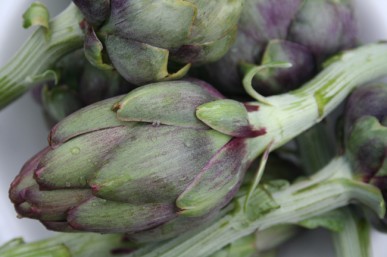Artichokes (Cynara scolymus) are striking plants that are both beautiful and useful. The arching soft grey green leaves and huge vibrant purple thistle flowers make a dramatic statement and add structure and contrast foliage. But they do take up a lot of space so make sure you’ve got plenty of room before planting. These short lived perennials are native to the Mediterranean region and take about 6 months from planting until they produce flower buds. The most readily available cultivars are Green globe, Violetta and Imperial Star.
Artichokes can be grown from seed but seed germination is often patchy and the quality varies enormously, so it is better to grow new plants by purchasing one or detaching and replanting a rooted offset. To remove offsets push a spade down carefully between the main stem and the offset so that you remove the small plant with leaves and roots. Trim off any outer leaves and woody roots and replant. Artichokes are best planted in mid to late winter in frost-free areas, or spring where there are frosts.
Planting and Growing
Artichokes do best in temperate regions with warm summers and mild winters. They will grow in the sub-tropics but may need to be put into raised beds so they don’t get too wet. They won’t grow in the tropics.
Artichokes stay in the same position for several years so soil preparation is important. They do best in sunny position in good sandy soil, enriched with compost and well-rotted manure. The soil needs to be slightly alkaline so add some dolomite before planting and some potash to ensure prolific flowering. Make sure they have plenty of space, as they reach a height of 1.2-2m and can be 1.5m across. Protect young plants from frost during winter by loosely covering with straw or bracken, pull this away once the weather warms up.
Water well when young and mulch with straw or hay. Mulch again in autumn and, once the leaves start to yellow, cut back the whole plant to just above the ground. The following spring several new plants will grow around the base of the old stem. These can be left to grow, or one or more detached and replanted. If a couple are detached each year you will always have new artichokes to replace any that die. The more care each plant gets the better the yields will be but I find artichokes to be tough, easy to grow plants that once established don’t need much attention
Harvesting
The peak harvest time is spring, but harvesting will continue sporadically through summer and then there may be another flush of flowers in autumn. Always pick flower buds before they begin to open, with a few centimeters of stem attached. I love the very young tender buds so I begin harvesting quite early. These buds are more tender and don’t need to have the ‘choke’ removed.
Pests and diseases
Artichokes are pretty much pest and disease free, except for crown rot if they are grown in regions with high humidity. The only way to combat this is to grow them in raised, very well-drained beds, and only water at ground level.
Using
Artichokes make great windbreaks in bigger gardens and when in flower they are very attractive to beneficial insects, especially ladybirds, but their main attraction is the delicious edible nutty-flavoured flower head.
Many people grow artichokes but are then not sure when to harvest and how to eat them. They are often put off by the idea of the hairy ‘choke’ made up of immature florets and so named because if you eat it, it can cause you to choke. The edible parts are the lower portions of the leaves (technically involucral bracts) and the base or ‘heart’ of the flower.
Medicinally, eating artichokes aids digestion, strengthens the liver and gall bladder and reduces the risk of heart disease by lowering cholesterol.
Preparing and eating
There are many ways to prepare and eat artichokes, but the following is the simplest. Pick the flower buds and leave them whole with the stem attached. Place them in a saucepan half filled with water. Add salt to the water and leave the lid off. Boil until a sharp knife pushed into the centre enters easily (about 20 minutes). If you are preparing artichokes before you want to cook them then leave them soaking in water to which some lemon juice or vinegar has been added. This will stop them going brown.
Once cooked, to eat them, remove the outside ‘leaves’ one at a time and dip the base into butter, salad dressing, lemon or aioili. Using your teeth, scrape the flesh from the base of the leaf and discard the rest. When you get to the ‘heart’ remove the cap at the centre. The ‘choke’ is just below. If the ‘choke’ is very fibrous (in older/larger flower buds) then remove this and discard, then eat the rest of the heart and stem. If it is a young flower head the choke will not have developed so the whole of the heart is eaten.







1 Comment
I have just germinated a packet of violetta artichokes that I bought last year and wanted to know how to prepare the soil for planting- thanks. I’m pleased also that you say they are good as a wind break as I’m hedging them against the fence for that reason.